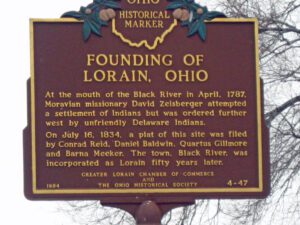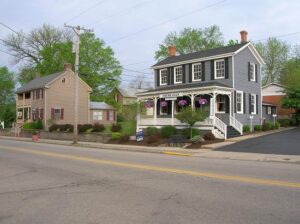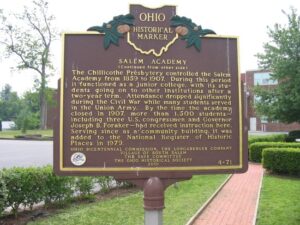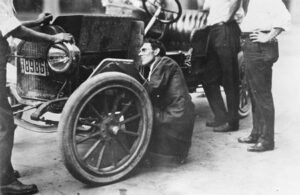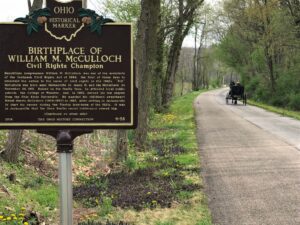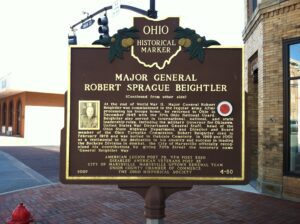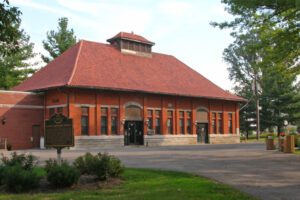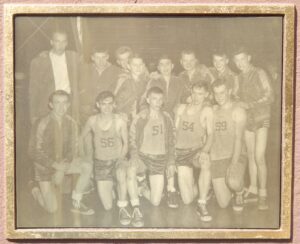, OH
At the mouth of the Black River in April, 1787, Moravian missionary David Zeisberger attempted a settlement of Indians but was ordered further west by unfriendly Delaware Indians. On July 16, 1834, a plat of this site was filed by Conrad Reid, Daniel Baldwin, Quartus Gillmore and Barna Meeker. The town, Black River, was incorporated as Lorain fifty years later.
, OH
David and Rachel Burnet Evans built this Federal style house in 1836. Their son, Dr. John Evans (1814-1897), nationally known physician, statesman, and educator, lived here as a young man. After graduating from Lynn Medical College in Cincinnati, Dr. Evans became a prominent physician in Indiana and helped establish the Indiana Hospital for the Insane. He is recognized as one of the founders and first president of Northwestern University in Evanston, Illinois. He was appointed by President Abraham Lincoln as the first governor of the Colorado Territory and is credited for developing the railroad system in Colorado. His desire to institute a system of higher education in the territory led to the founding of Colorado Seminary, later known as Denver University. Evanston, Illinois and Mt. Evans near Denver were named in his honor.
, OH
Presbyterian minister Hugh Stewart Fullerton asked his congregation in 1841: “Shall we endeavor to form an academy to provide better educational advantages to the young citizens of this remote community?” Predating the founding of the town of South Salem, the Salem Academy was built and opened in 1842, its stone coming from a quarry south of Greenfield. Its primary purpose was to prepare ministers and teachers for the West. Professor J.A. Lowes served as principal during the “golden age” of the academy from 1848 to 1858. (continued on other side)
, OH
Charles F. “Boss” Kettering was a prolific inventor. While at National Cash Register, he invented the first electric cash register. Kettering founded the Dayton Engineering Laboratories Company (Delco) in 1909 and developed the electric self-starter for automobiles, first used in 1912 Cadillacs. He also developed no-knock Ethyl gasoline, lacquer car finishes, four-wheel brakes, safety glass, and high-compression engines; made significant improvements to diesel engines that led to their use in locomotives, trucks, and buses; and collaborated with Thomas Midgley, Jr. in the development of the refrigerant Freon. Kettering served as President of the Society of Automotive Engineers in 1918, co-founded the Engineers’ Club of Dayton (1914), and was director of research at General Motors Corporation from 1920 to 1947. His interest in medical and scientific research led to the founding of the Kettering Foundation and the Sloan-Kettering Institute for Cancer Research.
, OH
Republican congressman William M. McCulloch was one of the architects of the landmark Civil Rights Act of 1964, the first of three laws to recommit the nation to the cause of civil rights in the 1960s. “Bill” McCulloch was born near Holmesville to James H. and Ida McCulloch on November 24, 1901. Raised on the family farm, he attended local public schools, the College of Wooster, and, in 1925, earned his law degree from the Ohio State University. He married his childhood sweetheart Mabel Harris McCulloch (1904-1990) in 1927, after settling in Jacksonville to start his career during the Florida land-boom of the 1920s. It was in Jacksonville that the Deep South’s racial intolerance seared him. (Continued on other side)
, OH
Robert Sprague Beightler was born in 1892 in Marysville. A graduate of Marysville High School, he began his career as a soldier in 1911, when he enlisted as a private in Marysville’s guard unit, Company E, Fourth Ohio Infantry Regiment. He served in Mexico from 1916-1917, World War I from 1917-1919, and World War II from 1940-1945. From his stint with the Ohio Infantry, he rose in rank to command the famous 37th Ohio National Guard Buckeye Division as Major General during WWII. Beightler was one of the most successful National Guard Generals and the only National Guard General to lead his troops through both training and combat in WWII. He was with his troops through 700 days of fighting in the South Pacific Theater. Fighting occurred on Bougainville Island and in the islands of New Georgia and the Philippines. (Continued on other side)
, OH
Frances Rappaport Horwich was born in Ottawa on July 16, 1907, the daughter of Sam Rappaport, an Austrian immigrant who operated a general store, and Rosa Gratz Rappaport, a Russian immigrant. The youngest of six children, she attended the Ottawa elementary school and graduated from Ottawa High School in 1924. After high school, she attended the University of Chicago where she earned a bachelor’s degree in philosophy and taught first grade for three years. “Miss Frances,” as she was called, then earned a master’s degree from Columbia University in 1933 and a Ph.D. in 1942 from Northwestern University. From 1942 to 1952, she was involved in teaching and education development. The basic education she received in the Ottawa schools enabled her to achieve great skills and abilities. [continued on other side]
, OH
Team photograph here Standing, L to R: Coach C. Norris Simpson, Donald Alt, Bill Ziegler, Roy Meyer, Jerry Kuhlman, Karl Inkrott, Vern Schroeder, Mel Lammers Kneeling, L to R: Joe Lammers, Junior McDonald, Frank Schroeder, Ralph (Skip) Meyer, Dick Barlage Team manager: Charles Warnimont Cheerleaders: Betty Lou Meyer, Agnes Riepenhoff, Clara Schroeder, Audrey Wischmeyer School colors: Blue and Gold “You have got to have the boys and I had the boys” –Coach C. Norris Simpson


